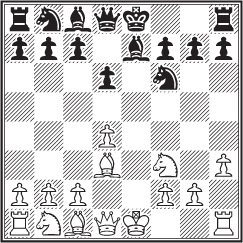
The outcome of this game seems routine, unless you know of the other meetings between the two players. Florin Gheorghiu was a promising Rumanian who had ended Fischer’s six-year run as the world’s youngest GM when he earned the title in 1964. Two of their four games were drawn and in the third, Gheorghiu took only 55 minutes to beat Fischer in 50 moves.
Fischer – Florin Gheorghiu
Buenos Aires 1970
Petroff Defense (C42)
1 |
e4 |
e5 |
2 |
♘f3 |
♘f6 |
3 |
♘xe5 |
d6 |
4 |
♘f3 |
♘xe4 |
5 |
d4 |
♗e7!? |
6 |
♗d3 |
♘f6 |
7 |
h3 |
|

Black’s super-conservative play (in place of 5...d5) suggests White will have an easy time getting a substantial edge. Yet the position soon resembles an Alekhine’s variation that goes 1 e4 ♘f6 2 e5 ♘d5 3 c4 ♘b6 4 d4 d6 5 exd6 exd6 6 ♘c3 ♗e7 7 ♘f3 0-0 8 h3 and is considered only slightly better for White. (In this game Black should be better off than that because his knight stands on f6, not b6.)
7 |
... |
0-0 |
8 |
0-0 |
♖e8 |
9 |
c4! |
|
Now 9...c5 10 d5 ♗f8 11 ♘c3 a6 12 a4 fails to equalize as did the slower approach, ...♘bd7-f8-g6 and ...♗f8, in early 20th Century tests.
9 |
... |
♘c6 |
Petrosian revealed how much he had studied Fischer’s games when he improved against Fischer in their Candidates match with 9...c6 10 ♘c3 ♘bd7 11 ♖e1 ♘f8 12 ♗f4 a6 13 ♕b3 and now 13...♘e6 14 ♗h2 ♗f8 15 ♖e2 b5!.
10 |
♘c3 |
h6 |
11 |
♖e1 |
♗f8 |
Black’s only real problem is the log jam of pieces on his first two ranks. He needs to develop his QB, followed by ...♕d7.
12 |
♖xe8 |
♕xe8 |
13 |
♗f4 |
♗d7 |
On 13...♘b4 14 d5 ♘xd3 15 ♕xd3 g6 Black can untangle – but not after 14 ♗b1!.
14 |
♕d2 |
|
Annotators were quick to sacrifice White’s pieces with 14...g5 15 ♗xg5 hxg5 16 ♕xg5+ although the compensation is barely visible after 16...♗g7 17 ♖e1 ♕d8 18 ♖e3 ♖e8. Better is 15 ♖e1 ♕d8 16 ♘xg5!.
14 |
... |
♕c8 |
Black expected to play ...♗f5xd3 since 15 g4? allows 15...♗xg4.
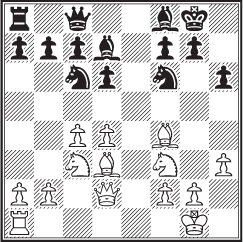
15 |
d5! |
♘b4 |
16 |
♘e4! |
|
This is what Black missed (16...♘xd3 17 ♘xf6+).
16 |
... |
♘xe4 |
17 |
♗xe4 |
♘a6 |
Now he can solve the QB-problem with 17...a5 18 a3 ♘a6 19 ♕xa5 ♘c5 but that isn’t worth a pawn.
18 |
♘d4 |
|
A younger Fischer might have sought a queenside bind with 18 b4 (18...b5 19 cxb5 ♗xb5 20 ♘d4 ♗d7 21 ♖c1) rather than kingside attack.
18 |
... |
♘c5 |
19 |
♗c2 |
a5 |
20 |
♖e1 |
♕d8 |
Again the annotators liked 20...g5 21 ♗xg5? hxg5 22 ♕xg5+ ♗g7 23 ♖e7 but that’s refuted by 21...♕d8! and 22...♔f8.
21 |
♖e3 |
|
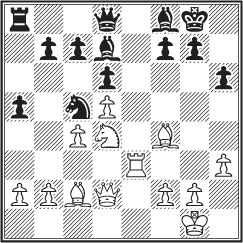
21 |
... |
b6 |
Here Black overlooks White’s reorganizing idea (♘f3/♗e3-d4). Emanuel Lasker would have tried 21...g5 22 ♖g3 ♗g7. The black kingside is remarkably resilient. For example, 23 ♗e3 ♕e7 24 h4 ♘e4 25 ♗xe4 ♕xe4 26 hxg5 h5. Or 23 f4 ♘e4! 24 ♗xe4 ♕xe4 25 hxg5 ♗e5.
♖g3 |
♔h8 |
|
23 |
♘f3! |
♕e7 |
Not 23...♕f6 24 ♗e3! and ♗d4.
24 |
♕d4! |
|
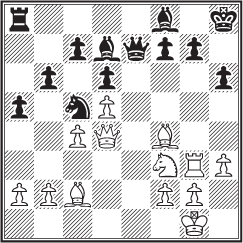
24 |
... |
♕f6 |
White wins after 24...f6 25 ♘h4 ♕e2 26 ♘g6+ ♔g8 27 ♗xh6! ♕xc2 28 ♘xf8 ♖xf8 29 ♖xg7+ and 30 ♖e7.
25 |
♕xf6 |
gxf6 |
26 |
♘d4! |
♖e8 |
27 |
♖e3 |
♖b8 |
After a trade of rooks White’s fastest win is ♗f5.
28 |
b3 |
b5 |
Losing a pawn but 28...♗e8 29 ♘f5 h5 30 ♘g3 h4 shouldn’t prolong Black’s life much, e.g. 31 ♘f5 b5 32 ♘xh4 bxc4 33 bxc4.
29 |
cxb5 |
♗xb5 |
30 |
♘f5 |
♗d7 |
31 |
♘xh6 |
♖b4 |
32 |
♖g3! |
♗xh6 |
The threat was 33 ♖g8 mate, and 32...♗g7 33 ♘xf7+ ♔g8 34 ♘h6+ ♔f8 35 ♗e3 was of little help.
33 |
♗xh6 |
♘e4 |
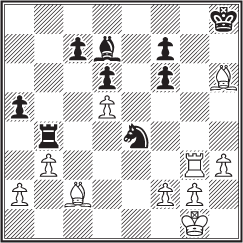
34 |
♗g7+ |
♔h7 |
Or 34...♔g8 35 ♗xe4 ♖xe4 36 ♗xf6+ ♔f8 37 ♖c3.
35 |
f3 |
Resigns |